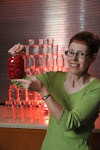Sodium Intakes in US School Children
The CDC just released a report detailing sodium intake in
school-aged children, using information gathered in 2009-2010 from the National
Health and Examination Survey (NHANES): http://www.cdc.gov/mmwr/preview/mmwrhtml/mm6336a3.htm?s_cid=mm6336a3_w
Sodium intakes are a concern due to associations of high
intakes with hypertension (high blood pressure) – a contributor to stroke and
heart disease.
 Children had an average sodium intake of 3,279 mg/day,
higher than the Healthy People 2020 for the US population ≥2 years old: 2,300
mg. The highest intake of total sodium was in boys and high school students;
adjusted per 1000 kcals consumed, the highest intakes were in high school
children. This suggests sodium intake increases as children take in more
food-but selections among high school students also contain more sodium
relative to their calorie content than selections of younger children. There
were generally no differences in sodium intakes among race/ethnic groups, among
groups with different household incomes, and between children of normal weight
vs. those who were overweight.
Children had an average sodium intake of 3,279 mg/day,
higher than the Healthy People 2020 for the US population ≥2 years old: 2,300
mg. The highest intake of total sodium was in boys and high school students;
adjusted per 1000 kcals consumed, the highest intakes were in high school
children. This suggests sodium intake increases as children take in more
food-but selections among high school students also contain more sodium
relative to their calorie content than selections of younger children. There
were generally no differences in sodium intakes among race/ethnic groups, among
groups with different household incomes, and between children of normal weight
vs. those who were overweight.
There were interesting findings for food sources of
sodium. The largest contributors are: pizza, yeast breads, cold cuts &
cured meats, savory (not sweet) snacks, sandwiches, cheese, processed chicken
products (nuggets, etc.), pasta dishes, Mexican dishes, and soups. There were
other categories that contributed sodium when the data was arranged by age and
ethnic groups, and this detail is available at the link above. The majority of
sodium was contributed by grocery store foods; however, fast foods contributed
the most sodium per kcal. For those children eating a school meal on the day
this information was gathered, 26% of their sodium came from school foods. On a
per meal basis, 14.9% comes from breakfast; 29.5% from lunch, 39.2% from
dinner, and 16.4% from snacks.
These data suggest that sodium intakes reflect similar
types of foods consumed across different populations of children, and supports
ongoing efforts to reduce sodium in processed foods purchased both in grocery
stores and restaurants, and served in school settings.
Families are encouraged to purchase foods naturally low
in sodium such as fruits and vegetables. Fruits and vegetables provide other
nutrients, such as potassium, which play a role in reducing high blood
pressure. Alternatives to some of the commonly consumed foods such as pizza,
cold cuts, and processed chicken products may include lower sodium versions or
whole food alternatives such as lean meat and whole grain/high fiber
carbohydrates. Reading food labels is
key in making the best selections possible among processed foods such as bread
products, breakfast cereals, and snack foods.
Source: Beth Olson, UW-Extension Nutrition Specialist




No comments:
Post a Comment